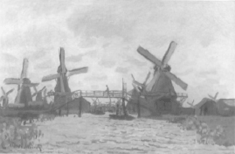Van Gogh Museum Journal 2001
(2001)– [tijdschrift] Van Gogh Museum Journal–
[pagina 139]
| |
Catalogue of acquisitions: paintings and drawings
| |
PaintingsAmiet, Cuno
| |
Dupré, Jules
| |
[pagina 140]
| |
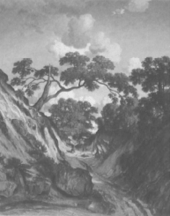 the Paris Salon in 1831; that same year he travelled to England where he was impressed by the works of John Constable and John Crome. Upon returning to Paris he worked with such artists as Théodore Rousseau and Constant Troyon; from 1840 he would paint around the village of Barbizon, and later in the Pyrenees and at L'Isle-Adam. Dupré executed The sunken path between 1835 and 1840. One of the painting's striking features is the contrast between the clear blue sky and the dark trees and shaded areas on the right and in the foreground. This is underlined by the expressive, visible brushwork used to create the landscape and the fine, smooth technique employed for the sky. In painting the scene, Dupré chose a fairly high viewpoint, beside the sunken road. This stance and the theatrical composition lead the viewer's eye down the path and into the depths of the painting, where a herd of cows has been rendered with confident brushstrokes. In a second version of the painting, produced during the same period and now in a private collection, the cows are absent. It is not known which version is the earlier. A pencil drawing, also in private hands and depicting a similar location in the winter, may have been a preliminary study for the two paintings. The Van Gogh Museum acquired a watercolour by Dupré in 1997; this is the first oil painting by the artist in the museum's collection.
Provenance A. Marmontel; Hôtel Drouot (Paris), 28 and 29 March 1898, lot 94; Alfred Beurdeley; Galerie Petit (Paris), 6 May 1920, lot 47; private collection; Brame & Lorenceau (Paris); purchased by the Van Gogh Museum (2001). Literature Marie-Madelaine Aubrun, Jules Dupré 1811-1889: catalogue raisonné de l'oeuvre peint, dessiné et gravé, Paris 1974, no. 97; exhib. cat. Barbizon et l'école de la nature, Paris (Galerie Brame et Lorenceau) & London (Agnew's) 1992, no. 16. | |
Monet, Claude-Oscar
| |
[pagina 141]
| |
are the most amusing things everywhere. Houses of every colour, hundreds of windmills and enchanting boats, extremely friendly Dutchmen who almost all speak French.’Ga naar voetnoot8 Monet's works from Zaandam cannot be set in any clear, chronological order. He explored various aspects of the town and the surrounding areas, from views of the harbour and its buildings to more panoramic vistas of the Zaan River. As a group, the pictures are diverse in both mood and approach, displaying considerable experimentation in the techniques of outdoor painting. Several seem closely related in style and subject to the nascent impressionism of Monet's work at La Grenouillère in 1869, with rapid brushwork and a bright palette. Others seem more subdued and conventional, inviting comparison with the work of established masters such as Daubigny. The Van Gogh Museum's Mills at Westzijderveld counts as one of the more daring of the Zaandam pictures. It is one of a small group of works painted fig. 1
Westzijderveld at Zaandam, c. 1900, Zaanstad, Gemeentearchief  fig. 2
Westzijderveld at Zaandam, c. 1900, Zaanstad, Gemeentearchief in Westzijderveld which, as the name implies, is an area to the west of the town, a polder landscape criss-crossed with ditches and canals and dotted with an abundance of windmills and their outbuildings (figs. 1 and 2). This area still retains something of its original character although the precise location painted by Monet can no longer be identified with any certainty. The artist did, however, render sufficient detail to be able to identify all but the mill second from the left as so-called smock windmills (bovenkruiers). In this region they were in use mainly as sawmills, the top half of the structure being swivelled to optimise the angle of the sails to the wind. In the painting the sails are depicted in the typical summer colours of orange and white, this last gradually discolouring in the wind and rain to become the murky grey Monet has recorded. In late October the sails were changed to their traditional winter colours of yellow and brown. The foreground of the painting is dominated by the view along a wide ditch brimming with water and crossed by a series of wooden footbridges. Behind the mills, blocks of grey cloud mask the sunlight in a subtle contre-jour effect. Monet uses combinations of sombre greens, greys and mauves to evoke an overcast day under a water-laden Dutch sky, an effect that serves to heighten the dramatic orange-red of the windmill sails. As with many of the Zaandam pictures the viewpoint suggests the artist was working from a boat, and the swift handling suggests that all or most of the work was executed on the spot. As Ronald Pickvance has observed, this is ‘one of Monet's most direct and confident paintings of Zaandam.’Ga naar voetnoot9 In many areas of the picture he applied his paint with fluid, block-like strokes, using the square-ended brushes that he favoured in the early 1870s. By contrast the rippling water is depicted with simple, almost child-like scribbles, which seem to be unique to this picture. Traces of an earlier composition are still visible beneath the present work. It is possible that Monet painted over an earlier work, although x-radiographs give no indication of what this might have been. At Zaandam Monet made some studies of similar subjects under differing conditions of light and weather. A painting of an analogous view in Westzijderveld has a contrasting sunset effect.Ga naar voetnoot10 The calm water reflects a tranquil sky, while the windmills, with their sails tilted away from the viewer, lead the eye gently into depth, evoking the mood of river scenes by mid-19th-century masters such as Daubigny or Corot. The Van Gogh Museum picture, however, is remarkable for its audacious composition. Any effect of recession suggested by the ditch is immediately countered by the flat silhouette of the windmills and their sails, establishing the almost abstract pattern across the canvas that prompted Pickvance to compare the design with Mondrian's early river scenes.Ga naar voetnoot11 The emphatic two-dimensionality of the composition has also been compared to Japanese prints. The story that Monet ‘discovered’ Japanese art by accident during his first trip to Holland is no longer accepted, but certain features in the Dutch landscape may have helped to stimulate his interest in such woodblock prints. One of the pencil sketches Monet made as he scouted for subjects in this area shows a wooden footbridge not unlike the one in the Van Gogh Museum painting. The delicate form of the bridge in the drawing has been convincingly compared to a print of a similar motif by Hokusai.Ga naar voetnoot12 This particular parallel may be coincidental but in a more general way the strong sense of surface pattern in Mills at Westzijderveld seems to reflect the artist's awareness of the bold compositional devices of Japanese prints. When in 1872 Eugène Boudin saw the works Monet had made at Zaandam he wrote to a friend: ‘He has brought some very beautiful studies from Holland and I believe that he is meant to take one of the leading places in our school.’Ga naar voetnoot13 The significance of Monet's first journey to the Netherlands has long been recognised. If his period of exile in London was something of a hiatus, at Zaandam he was able to recapture the creative energy of the works painted at La Grenouillère and Trouville in 1869 and 1870, and to take forward his experiments with outdoor painting. In commercial terms the trip seems also to have been something of a success. Durand-Ruel bought a number of the Zaandam pictures, including our Mills at Westzijderveld near Zaandam. It was later acquired by Max Liebermann.Ga naar voetnoot14 As an admirer of Monet and an enthusiastic visitor to Holland (by chance Liebermann was also in the Netherlands in 1871) it is no surprise that the German painter should have been attracted to this picture.
Provenance Acquired from Monet by Durand-Ruel (either in September 1872 as La Passerelle or in February 1873 as Moulin de Bois); 7. Internationale Kunstausstellung der Münchner Sezession, Munich 1899, no. 200 (owner not identified); between 1899 and 1909 acquired by Max Liebermann, Berlin; together with other works from Liebermann's collection, in Kunsthaus (Zurich), 9 May 1933;Ga naar voetnoot15 to Liebermann's daughter Käthe Liebermann and her hus- | |
[pagina 142]
| |
band Kurt Riezler, by whom sold to Paul Rosenberg & Co., New York (1943);Ga naar voetnoot16 Harry N. Abrams (1949); gift of Mr and Mrs Abrams to The Metropolitan Museum of Art, New York (1968); de-accessioned in 1969 to the Wildenstein Gallery;Ga naar voetnoot17 private collection, USA; purchased by the Van Gogh Museum through Hirschl and Adler Galleries (New York) with funds provided by the Dutch Sponsor Lottery, the Stichting Nationaal Fonds Kunstbezit, the Vereniging Rembrandt, supported by the Prins Bernhard Cultuurfonds and a donation from VNU, the Ministry of Education Culture and Science; the Mondrian Foundation, the VSB Fonds and the Vincent van Gogh Foundation (2001). The donation from the Stichting Nationaal Fonds Kunstbezit was made possible with contributions from Philips Electronics, Shell, Unilever, ABN AMRO, ING, Fortis and Heineken.
Literature Daniel Wildenstein, Claude Monet: biographie et catalogue raisonné, vol. 1, Lausanne 1974, p. 53 (reprinted Paris 1997, vol. 2, p. 84, no. 181); exhib. cat. Monet in Holland, Amsterdam (Van Gogh Museum) 1986, no. 3; exhib. cat. Peter Sutton et al., European paintings from private collections of friends of the Museum of Fine Arts, Boston, Boston (Museum of Fine Arts) 1992, no. 92; Marianne Alphant, Claude Monet in Holland/en Hollande, Paris 1994, p. 32; Louis van Tilborgh, ‘Claude Monet, Molens in het Westzijderveld bij Zaandam en Gezicht op de Prins Hendrikkade en de Kromme Waal te Amsterdam,’ Bulletin van de Vereniging Rembrandt 11 (Spring 2001), pp. 19-24. View of the Prins Hendrikkade and the Kromme Waal in Amsterdam 1874 Monet's second visit to Holland is shrouded in mystery. There are 12 views of Amsterdam which, to judge from their style, were painted in 1873 or 1874. None of these works, however, were dated by the artist, and not a single document survives to record Monet's presence in the Netherlands during those years. Most of the 12 works disappeared quickly into private collections, bypassing his dealers, and Monet himself never exhibited any of them. None of the Amsterdam views were on display in the early group shows of the impressionists. There is no record of the painter's whereabouts between the end of January and 1 April 1874, and so it seems likely he made a brief visit to Amsterdam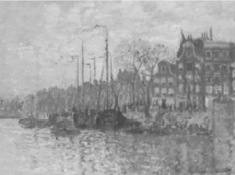 during this period. The pictures themselves offer no clear clues for a more precise dating; two of them are snow scenes, several others are wintry in effect, while two paintings show trees that appear to be just coming into leaf. We can only speculate on the reasons Monet returned north at this particular moment. It has been suggested that it was a form of artistic retreat, allowing the painter to experiment away from the distraction of his friends and colleagues.Ga naar voetnoot1 However, a more commercial motive cannot be ruled out. Most of his subjects were familiar tourist landmarks that had already been frequently reproduced in guides, postcards and prints. Some of the pictures, such as the view of the Roozenboom mill seem blatantly picturesque in composition.Ga naar voetnoot2 As with the Zaandam picture discussed above, the View of the Prins Hendrikkade and the Kromme Waal in Amsterdam must have been painted from a boat. The subject is located not far from the city's central railway station. The houses at the right stand on what is now called Prins Hendrikkade (before 1879 known as Kamperhoofd). The buildings, though somewhat altered, are still recognisable today (fig. 3). The boats to the left are moored in Waalseilandsgracht, while in the distance Monet has shown parts of Kromme and Oude Waal, which lead towards the centre of the city. A larger painting now in the Rau Foundation collection shows the same group of buildings but from around the corner.Ga naar voetnoot3 It seems that Monet may have manipulated the scenery to suit his own compositional ends. A drawing by Carel Storm van 's-Gravensande, showing much the same view as the Van Gogh Museum's picture, clearly records a bridge over Waalseilandsgracht that Monet seems to have edited out (fig. 5). | |
[pagina 143]
| |
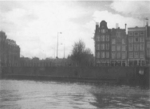 fig. 3
View of the Prins Hendrikkade, 2001, photographed by Reindert Groot  fig. 4
View of the Prins Hendrikkade, c. 1910, Amsterdam, Gemeentearchief  fig. 5
C.N. Storm van 's-Gravensande, View of the Prins Hendrikkade, 1880, Amsterdam, Gemeentearchief It also seems that the bridge pier at the right of Monet's painting was not actually visible from this vantage point. Perhaps Monet felt the need for a feature here to add interest to the foreground. In technique the view of Amsterdam is quite different from the earlier vista of Zaandam. If in the terms familiar to the impressionists the latter could be described as an étude (a finished picture painted directly from nature), then the View of the Prins Hendrikkade is a pochade, i.e. a rapid and freely painted sketch. By 1874 Monet was using a variety of different brushstrokes to bring his subjects to life. Here, soft dabs of paint recreate the characteristic canal-side buildings of Amsterdam; small, nervous touches define the skimpy, leafless trees, while longer trails of liquid paint are used to capture the flickering reflections in the water. Monet began by laying in both sky and water with a base colour of pinkish grey. This colour and the grey priming layer are left exposed throughout the picture, acting as a unifying element in the colour scheme.Ga naar voetnoot4 The arrangement of the composition has a simplicity verging on artlessness. The real interest in the picture lies in the rendering of light and atmosphere. The artist's muted colours and delicate handling conspire to evoke the subtle, watery light of Amsterdam, tempered by a play of ever-changing reflections. The first recorded owner of View of the Prins Hendrikkade was Eugène Murer, a pâtissier, amateur writer and painter who amassed a substantial collection of works by the impressionists in the later 1870s. In the 1880s Murer owned a hotel in Rouen, and works from his collection were regularly on view there.Ga naar voetnoot5 A change of fortune forced him to sell most of his pictures in the later 1890s. The View of the Prins Hendrikkade was acquired by another enthusiastic collector of impressionism, Pieter van de Velde. The painting remained in private hands in France and, with the exception of an appearance at auction in 1989, does not seem to have been shown in public for over 100 years.
Provenance Purchased from Monet in 1877 by Eugène Murer; by 1900 in the collection of Pieter van de Velde, Le Havre;Ga naar voetnoot6 to Henri Thieullent (1922);Ga naar voetnoot7 by descent to a private collection, France (1957); sold by the latter at auction, Paris (Drouot-Montaigne), 8 April 1989, lot 38; Lake; private collection, Japan; Noortman Gallery, Maastricht; purchased by the Van Gogh Museum with funds provided by the Dutch Sponsor Lottery, the Stichting Nationaal Fonds Kunstbezit, the Vereniging Rembrandt, supported by the Prins Bernhard Cultuurfonds and a donation from VNU, the Ministry of Education Culture and Science; the Mondrian Foundation, the VSB Fonds and the Vincent van Gogh Foundation (2001). The donation from the Stichting Nationaal Fonds Kunstbezit was made possible with contributions from Philips Electronics, Shell, Unilever, ABN AMRO, ING, Fortis and Heineken.
Literature Trublot [Paul Alexis], ‘A minuit. La collection Murer,’ Le Cri du Peuple (21 October 1887), no. 56: Une vue de Hollande; Paul Gachet, Deux amis des impressionnistes: le Dr Gachet et Murer, Paris 1956, no. 56: Une vue de Hollande, marine; Daniel Wildenstein, Claude Monet: biographie et catalogue raisonné, vol. 1, Lausanne 1974, pp. 246-47 (reprinted Paris 1997, vol. 2, p. 129, no. 304); exhib. cat. Monet in Holland, Amsterdam (Van Gogh Museum) 1986, no. 32 (not shown in the exhibition); Marianne Alphant, Claude Monet in Holland/en Hollande, Paris 1994, p. 70; Louis van Tilborgh, ‘Claude Monet, Molens in het Westzijderveld bij Zaandam en Gezicht op de Prins Hendrikkade en de Kromme Waal te Amsterdam,’ Bulletin van de Vereniging Rembrandt 11 (Spring 2001), pp. 19-24. | |
[pagina 144]
| |
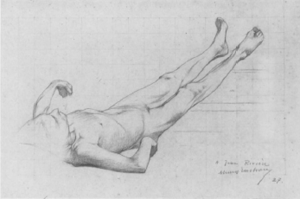 | |
DrawingsRachou, Henri
| |
Zandleven, Jan Adam
| |
[pagina 145]
| |
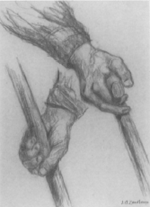 Zandleven mainly painted still lifes, forest views and landscapes. He was considerably influenced by the work of Vincent van Gogh, which was becoming increasingly well known in the Netherlands at the beginning of the 20th century. Zandleven's woodland scenes, interiors and farmhouses, produced in dark impasto colours, are inspired by the work of Van Gogh's Brabant period; his paintings of fruit trees in blossom are also modelled on Van Gogh's. The four Zandleven drawings donated last year to the Van Gogh Museum are the first works by the artist in the collection. Although the museum does not usually collect work by 20th-century Dutch artists, the obvious Van Gogh influence proclaimed by Zandleven's drawings make them of particular interest. They show that Van Gogh's works on paper, like his paintings, provided a valuable source of inspiration for later artists. Peasants digging and Study of hands were displayed at the 1962 exhibition J.A. Zandleven in the Dordrechts Museum. The exhibition catalogue assigns them to around 1903. Although there is no date on the drawings themselves, their style and subject suggest that Zandleven drew them during the early years of his artistic career, between 1902 and 1906, a period in which he produced a number of drawings of farmers working the land. Peasants digging has a strong resemblance to Van Gogh's 1885 black-chalk drawings of agricultural labourers, which Zandleven may have seen at the exhibition held in the Stedelijk Museum in 1905. The Study of hands - two hands holding a shovel - may be a preliminary study for Peasants digging. A forest, a dark sous-bois of tree trunks and thick foliage in black crayon, is less sketchy than the first two drawings. Zandleven uses brown and white crayon to bring some life to the scene. Although the drawing is not dated, its similarity in subject, treatment and technique to a drawing in the Kröller-Müller Museum (A forest, with heavy tree trunk in the foreground, black and coloured crayon, 1904) assigns it to the same early period. The Study of a tree is dated 1914; stylistically it also belongs to a later period than the other drawings. Van Gogh's influence is obvious in the tree trunk and the foreground. Zandleven has translated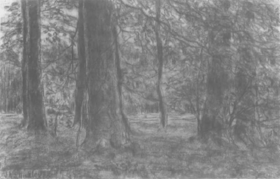 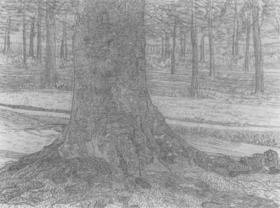 the typical brushwork found in Van Gogh's paintings from 1887-90 into small parallel lines, which he uses to create a decorative pattern that fills the surface.
Provenance Private collection; Stichting 't Schou, Schipluiden; donated to the Van Gogh Museum (2000).
Literature Exhib. cat. J.A. Zandleven, Dordrecht (Dordrechts Museum) 1962, nos. 124-25. |
|


